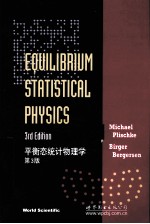图书介绍
平衡态统计物理学 英文版 影印本PDF|Epub|txt|kindle电子书版本网盘下载

- (加)普利史可著 著
- 出版社: 世界图书出版公司北京公司
- ISBN:7510024005
- 出版时间:2010
- 标注页数:620页
- 文件大小:20MB
- 文件页数:636页
- 主题词:平衡状态(热力学)-统计物理学-英文
PDF下载
下载说明
平衡态统计物理学 英文版 影印本PDF格式电子书版下载
下载的文件为RAR压缩包。需要使用解压软件进行解压得到PDF格式图书。建议使用BT下载工具Free Download Manager进行下载,简称FDM(免费,没有广告,支持多平台)。本站资源全部打包为BT种子。所以需要使用专业的BT下载软件进行下载。如BitComet qBittorrent uTorrent等BT下载工具。迅雷目前由于本站不是热门资源。不推荐使用!后期资源热门了。安装了迅雷也可以迅雷进行下载!
(文件页数 要大于 标注页数,上中下等多册电子书除外)
注意:本站所有压缩包均有解压码: 点击下载压缩包解压工具
图书目录
1 Review of Thermodynamics1
1.1 State Variables and Equations of State1
1.2 Laws of Thermodynamics3
1.2.1 First law3
1.2.2 Second law5
1.3 Thermodynamic Potentials9
1.4 Gibbs-Duhem and Maxwell Relations12
1.5 Response Functions14
1.6 Conditions for Equilibrium and Stability16
1.7 Magnetic Work18
1.8 Thermodynamics of Phase Transitions20
1.9 Problems24
2 Statistical Ensembles29
2.1 Isolated Systems:Microcanonical Ensemble30
2.2 Systems at Fixed Temperature:Canonical Ensemble35
2.3 Grand Canonical Ensemble40
2.4 Quantum Statistics43
2.4.1 Harmonic oscillator44
2.4.2 Noninteracting fermions44
2.4.3 Noninteracting bosons45
2.4.4 Density matrix46
2.5 Maximum Entropy Principle48
2.6 Thermodynamic Variational Principles53
2.6.1 Schottky defects in a crystal53
2.7 Problems54
3 Mean Field and Landau Theory63
3.1 Mean Field Theory of the Ising Model64
3.2 Bragg-Williams Approximation67
3.3 A Word of Warning69
3.4 Bethe Approximation71
3.5 Critical Behavior of Mean Field Theories74
3.6 Ising Chain:Exact Solution77
3.7 Landau Theory of Phase Transitions83
3.8 Symmetry Considerations86
3.8.1 Potts model87
3.9 Landau Theory of Tricritical Points90
3.10 Landau-Ginzburg Theory for Fluctuations94
3.11 Multicomponent Order Parameters:n-Vector Model98
3.12 Problems100
4 Applications of Mean Field Theory109
4.1 Order-Disorder Transition110
4.2 Maier-Saupe Model114
4.3 Blume-Emery-Griffiths Model120
4.4 Mean Field Theory of Fluids:van der Waals Approach123
4.5 Spruce Budworm Model129
4.6 A Non-Equilibrium System:Two Species Asymmetric Exclusion Model132
4.7 Problems137
5 Dense Gases and Liquids143
5.1 Virial Expansion145
5.2 Distribution Functions151
5.2.1 Pair correlation function151
5.2.2 BBGKY hierarchy157
5.2.3 Ornstein-Zernike equation158
5.3 Perturbation Theory161
5.4 Inhomogeneous Liquids163
5.4.1 Liquid-vapor interface164
5.4.2 Capillary waves169
5.5 Density-Functional Theory171
5.5.1 Functional differentiation171
5.5.2 Free-energy functionals and correlation functions174
5.5.3 Applications179
5.6 Problems181
6 Critical Phenomena Ⅰ183
6.1 Ising Model in Two Dimensions184
6.1.1 Transfer matrix184
6.1.2 Transformation to an interacting fermion problem188
6.1.3 Calculation of eigenvalues191
6.1.4 Thermodynamic functions194
6.1.5 Concluding remarks199
6.2 Series Expansions199
6.2.1 High-temperature expansions200
6.2.2 Low-temperature expansions206
6.2.3 Analysis of series206
6.3 Scaling211
6.3.1 Thermodynamic considerations211
6.3.2 Scaling hypothesis212
6.3.3 Kadanoff block spins215
6.4 Finite-Size Scaling218
6.5 Universality223
6.6 Kosterlitz-Thouless Transition226
6.7 Problems233
7 Critical Phenomena Ⅱ:The Renormalization Group237
7.1 The Ising Chain Revisited238
7.2 Fixed Points242
7.3 An Exactly Solvable Model:Ising Spins on a Diamond Fractal248
7.4 Position Space Renormalization:Cumulant Method258
7.4.1 First-order approximation262
7.4.2 Second-order approximation264
7.5 Other Position Space Renormalization Group Methods267
7.5.1 Finite lattice methods267
7.5.2 Adsorbed monolayers:Ising antiferromagnet268
7.5.3 Monte Carlo renormalization272
7.6 Phenomeno1ogical Renormalization Group275
7.7 The ε-Expansion279
7.7.1 The Gaussian model281
7.7.2 The S4 model284
7.7.3 Conclusion290
Appendix:Second Order Cumulant Expansion292
7.8 Problems295
8 Stochastic Processes303
8.1 Markov Processes and the Master Equation304
8.2 Birth and Death Processes306
8.3 Branching Processes309
8.4 Fokker-Planck Equation313
8.5 Fokker-Planck Equation with Several Variables:SIR Model316
8.6 Jump Moments for Continuous Variables321
8.6.1 Brownian motion323
8.6.2 Rayleigh and Kramers equations326
8.7 Diffusion,First Passage and Escape328
8.7.1 Natural boundaries:The Kimura-Weiss model for genetic drift329
8.7.2 Artificial boundaries331
8.7.3 First passage time and escape probability332
8.7.4 Kramers escape rate337
8.8 Transformations of the Fokker-Planck Equation340
8.8.1 Heterogeneous diffusion340
8.8.2 Transformation to the Schr?dinger equation343
8.9 Problems345
9 Simulations349
9.1 Molecular Dynamics350
9.1.1 Conservative molecular dynamics351
9.1.2 Brownian dynamics353
9.1.3 Data analysis355
9.2 Monte Carlo Method357
9.2.1 Discrete time Markov processes358
9.2.2 Detailed balance and the Metropolis algorithm359
9.2.3 Histogram methods363
9.3 Data Analysis365
9.3.1 Fluctuations365
9.3.2 Error estimates367
9.3.3 Extrapolation to the thermodynamic limit368
9.4 The Hopfield Model of Neural Nets371
9.5 Simulated Quenching and Annealing376
9.6 Problems379
10 Polymers and Membranes383
10.1 Linear Polymers384
10.1.1 The freely jointed chain386
10.1.2 The Gaussian chain389
10.2 Excluded Volume Effects:Flory Theory391
10.3 Polymers and the n-Vector Model395
10.4 Dense Polymer Solutions400
10.5 Membranes405
10.5.1 Phantom membranes406
10.5.2 Self-avoiding membranes409
10.5.3 Liquid membranes415
10.6 Problems418
11 Quantum Fluids421
11.1 Bose Condensation422
11.2 Superfluidity430
11.2.1 Qualitative features of superfluidity430
11.2.2 Bogoliubov theory of the 4He excitation spectrum439
11.3 Superconductivity442
11.3.1 Cooper problem443
11.3.2 BCS ground state445
11.3.3 Finite-temperature BCS theory449
11.3.4 Landau-Ginzburg theory of superconductivity453
11.4 Problems456
12 Linear Response Theory461
12.1 Exact Results462
12.1.1 Generalized susceptibility and the structure factor462
12.1.2 Thermodynamic properties469
12.1.3 Sum rules and inequalities470
12.2 Mean Field Response472
12.2.1 Dielectric function of the electron gas473
12.2.2 Weakly interacting Bose gas475
12.2.3 Excitations of the Heisenberg ferromagnet477
12.2.4 Screening and plasmons480
12.2.5 Exchange and correlation energy486
12.2.6 Phonons in metals487
12.3 Entropy Production,the Kubo Formula,and the Onsager Rela-tions for Transport Coefficients490
12.3.1 Kubo formula490
12.3.2 Entropy production and generalized currents and forces492
12.3.3 Microscopic reversibility:Onsager relations494
12.4 The Boltzmann Equation498
12.4.1 Fields,drift and collisions498
12.4.2 DC conductivity of a metal500
12.4.3 Thermal conductivity and thermoelectric effects503
12.5 Problems507
13 Disordered Systems513
13.1 Single-Particle States in Disordered Systems515
13.1.1 Electron states in one dimension516
13.1.2 Transfer matrix517
13.1.3 Localization in three dimensions523
13.1.4 Density of states525
13.2 Percolation530
13.2.1 Scaling theory of percolation533
13.2.2 Series expansions and renormalization group536
13.2.3 Rigidity percolation540
13.2.4 Conclusion542
13.3 Phase Transitions in Disordered Materials542
13.3.1 Statistical formalism and the replica trick544
13.3.2 Nature of phase transitions546
13.4 Strongly Disordered Systems551
13.4.1 Molecular glasses552
13.4.2 Spin glasses554
13.4.3 Sherrington-Kirkpatrick model558
13.5 Problems565
A Occupation Number Representation569
Bibliography583
Index603